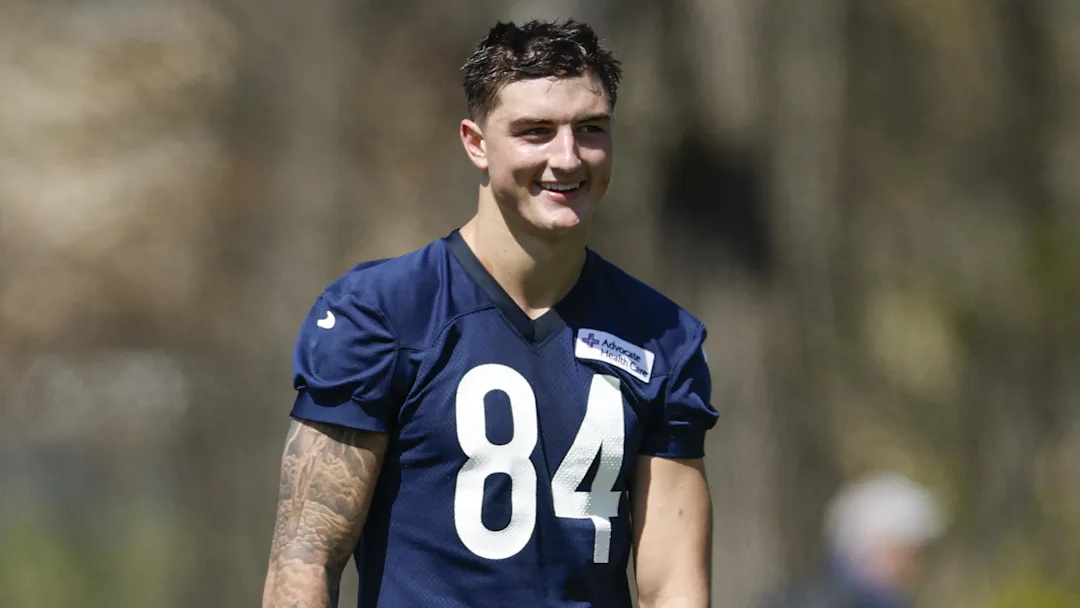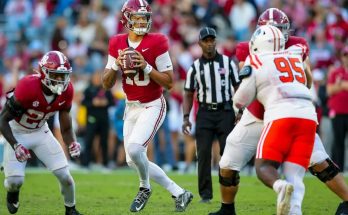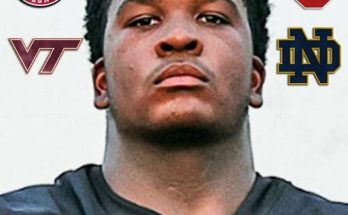Colston Loveland is no longer a secret. After years of steady development, explosive performances, and highlight-reel moments, the Chicago Bears tight end has officially arrived on the fantasy football radar—and not just as a sleeper or late-round flier. As the 2025 draft season heats up, Loveland’s stock is soaring, making him one of the most talked-about breakout candidates in fantasy football circles. From his chemistry with Caleb Williams to his rapidly expanding role in Shane Waldron’s offense, everything is pointing toward a fantasy eruption that managers won’t want to miss.
When the Bears selected Caleb Williams with the first overall pick in the 2025 NFL Draft, the national spotlight immediately shifted to Chicago’s offense. With DJ Moore already in place and Keenan Allen re-signing for one more season, many assumed the passing attack would revolve entirely around the wideouts. But insiders and film junkies quickly noticed something else: Williams had taken a shine to Loveland, the second-year tight end out of Michigan who finished his rookie year with modest numbers but impressive flashes.
Loveland’s rookie campaign wasn’t gaudy by traditional box score standards—just 36 catches for 401 yards and three touchdowns—but those numbers don’t tell the full story. He became more involved as the season progressed, ending the final month with an uptick in targets, route participation, and red zone usage. What started as a slow burn began to ignite in Week 15 when Loveland caught five passes for 61 yards and a score against Green Bay, showcasing his soft hands, body control, and ability to work the seams. By Week 18, it was evident that he wasn’t just an emergency outlet—he was a focal point in the offense.
Fantasy analysts took notice. And then came minicamp.
By all accounts, Loveland has been the star of the Bears’ offseason workouts. Reporters covering the team described him as “unguardable in space” and “the most consistent target on the field.” Williams has reportedly targeted him heavily in 7-on-7 drills, particularly in the red zone, where Loveland’s size (6-foot-5, 250 pounds) and leaping ability make him a mismatch nightmare. While veteran Allen is still expected to draw plenty of attention, it’s Loveland who has emerged as Williams’ safety blanket and potential touchdown machine.
In today’s NFL, tight end production is notoriously hard to predict outside of the elite tier. Travis Kelce, Mark Andrews, and George Kittle have long ruled the position, but there’s always room for a new name to crack the top five—and Loveland is primed to do exactly that. His fantasy upside is especially appealing in points-per-reception (PPR) formats, where his route tree and usage patterns suggest he’ll be involved on third downs, quick outs, and screens, in addition to traditional vertical routes down the seam.
One reason for the optimism is Waldron’s offensive scheme, which has consistently funneled opportunities to tight ends. During his tenure in Seattle, Waldron helped elevate the play of Gerald Everett and Noah Fant, both of whom had stretches of fantasy relevance under his watch. Loveland, however, is widely considered a more complete talent than either of those predecessors. He’s not just a red zone weapon or a chain-mover—he can do it all. From inline blocking to releasing off the line into a shallow cross or splitting out wide against a linebacker, he’s a chess piece that gives the Bears flexibility and unpredictability.
Fantasy managers are also drawn to Loveland’s path to volume. With Darnell Mooney now in Atlanta and Cole Kmet working back from a lingering hip issue, the tight end room is Loveland’s to command. There’s been no hesitation from the Bears’ coaching staff, who have publicly praised Loveland’s work ethic, football IQ, and leadership—even going so far as to compare his poise to that of veteran pros. He’s been in the building early, leaving late, and earning reps with the first team in every major situation. For fantasy players, that kind of consistency in camp is often a strong indicator of season-long opportunity.
In terms of draft strategy, Loveland presents one of the most intriguing values at the position. Currently going as the TE11 or TE12 in most early best-ball and redraft leagues, he offers top-five upside at a mid-round price. That kind of return on investment is what wins fantasy championships. More importantly, he plays in a division with suspect linebacker coverage units, giving him favorable matchups in at least six games this season. Factor in a schedule that includes teams like the Cardinals, Seahawks, and Commanders—all of whom struggled to contain tight ends in 2024—and the breakout potential becomes even more obvious.
The buzz isn’t limited to fantasy analysts, either. NFL scouts and opposing defensive coordinators have begun game-planning for Loveland as a true offensive threat. One AFC defensive assistant recently told a Chicago beat writer that Loveland “runs like a big wide receiver but blocks like a sixth offensive lineman,” which makes defending him a nightmare. That dual-threat ability means he’ll stay on the field in every situation—run-heavy formations, two-minute drills, and everything in between. And as every fantasy veteran knows, opportunity is everything.
It also helps that Loveland and Williams appear to have quickly developed off-field chemistry. According to multiple reports, the duo has been putting in extra reps before and after practices, working on timing, option routes, and back-shoulder throws. Their rapport is beginning to resemble the kind of quarterback-tight end bond that has defined some of the NFL’s most productive fantasy pairings over the last decade—think Mahomes and Kelce, or Lamar Jackson and Andrews. While it’s still early, the foundation is clearly being laid for something special in Chicago.
Another important element to consider is Loveland’s durability and college pedigree. At Michigan, he was known for his toughness, availability, and clutch play. He played through minor injuries and stepped up in big games, earning rave reviews from Jim Harbaugh and tight ends coach Grant Newsome. That experience in a pro-style offense helped ease his transition to the NFL, where he’s already shown the ability to adjust to complex route concepts and blocking schemes. In a position group where injuries can quickly derail seasons, Loveland’s reliability is a valuable asset.
There’s also something to be said about Loveland’s mentality. He’s confident without being cocky, intense without being reckless. Teammates have described him as a “dog” in practice—competitive, fearless, and always hungry for more. He’s even taken on a leadership role in the tight end room, mentoring younger players while holding himself accountable for missed assignments and drops. That maturity is rare for a player entering just his second season, and it bodes well for his long-term trajectory.



